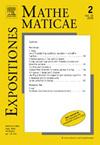Geometric quadratic Chabauty and p-adic heights
IF 0.9
4区 数学
Q2 MATHEMATICS
引用次数: 0
Abstract
Let be a curve of genus over whose Jacobian has Mordell–Weil rank and Néron–Severi rank . When , the geometric quadratic Chabauty method determines a finite set of -adic points containing the rational points of . We describe algorithms for geometric quadratic Chabauty that translate the geometric quadratic Chabauty method into the language of -adic heights and -adic (Coleman) integrals. This translation also allows us to give a comparison to the (original) cohomological method for quadratic Chabauty. We show that the finite set of -adic points produced by the geometric method is contained in the finite set produced by the cohomological method, and give a description of their difference.
几何二次恰布蒂和p进高度
设X是一条g>1 / Q的曲线,它的雅可比矩阵J有Mordell-Weil秩r和n - severi秩ρ。当r<g+ρ−1时,几何二次Chabauty方法确定了包含x的有理点的有限p进点集。我们描述了将几何二次Chabauty方法转换为p进高度和p进(Coleman)积分语言的几何二次Chabauty算法。这种转换也允许我们对二次Chabauty的(原始)上同调方法进行比较。证明了几何方法得到的p进点的有限集合包含在上同调方法得到的有限集合中,并给出了它们之间的差的描述。
本文章由计算机程序翻译,如有差异,请以英文原文为准。
求助全文
约1分钟内获得全文
求助全文
来源期刊
CiteScore
1.30
自引率
0.00%
发文量
41
审稿时长
40 days
期刊介绍:
Our aim is to publish papers of interest to a wide mathematical audience. Our main interest is in expository articles that make high-level research results more widely accessible. In general, material submitted should be at least at the graduate level.Main articles must be written in such a way that a graduate-level research student interested in the topic of the paper can read them profitably. When the topic is quite specialized, or the main focus is a narrow research result, the paper is probably not appropriate for this journal. Most original research articles are not suitable for this journal, unless they have particularly broad appeal.Mathematical notes can be more focused than main articles. These should not simply be short research articles, but should address a mathematical question with reasonably broad appeal. Elementary solutions of elementary problems are typically not appropriate. Neither are overly technical papers, which should best be submitted to a specialized research journal.Clarity of exposition, accuracy of details and the relevance and interest of the subject matter will be the decisive factors in our acceptance of an article for publication. Submitted papers are subject to a quick overview before entering into a more detailed review process. All published papers have been refereed.

 求助内容:
求助内容: 应助结果提醒方式:
应助结果提醒方式:


